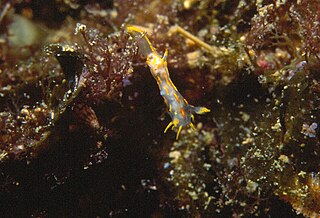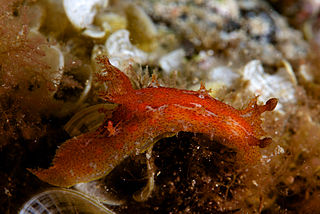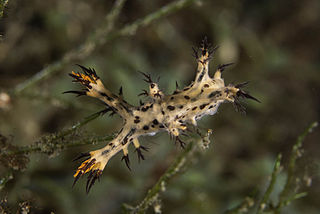
Felimare picta is a species of colourful sea slug or dorid nudibranch, a marine gastropod mollusk in the family Chromodorididae. Atlantic Ocean species of Hypselodoris were all transferred to Felimare following a DNA phylogeny.

The crowned nudibranch is a species of dorid nudibranch. It is a marine gastropod mollusc in the family Polyceridae.

Polycera quadrilineata, is a sea slug, a species of dorid nudibranch. It is a marine gastropod mollusc in the family Polyceridae. The specific epithet quadrilineata means four-lined and refers to the four longitudinal black lines present on the original specimen. This species is sometimes called the fourline nudibranch. In 2020 a integrative molecular and morphological study showed that P. quadrilineata was a complex of two species in the NE Atlantic and one of these species was given the new name Polycera norvegica.

The twin-crowned nudibranch, scientific name Polycera sp., as designated by Gosliner, 1987, is a species of dorid nudibranch. It is a marine gastropod mollusc in the family Polyceridae. As of November 2009, it was undescribed by science.

Halgerda carlsoni is a species of sea slug, a dorid nudibranch, shell-less marine gastropod mollusks in the family Discodorididae.

Hypselodoris maculosa is a species of sea slug or dorid nudibranch, a marine gastropod mollusk in the family Chromodorididae.
Mexichromis tica is a species of sea slug, a dorid nudibranch, a shell-less marine gastropod mollusk in the family Chromodorididae.
Felimare ciminoi is a species of colourful sea slug or dorid nudibranch, a marine gastropod mollusc in the family Chromodorididae.
Felimare xicoi is a species of colourful sea slug or dorid nudibranch, a marine gastropod mollusk in the family Chromodorididae.
Tyrinna burnayi is a species of sea slug or dorid nudibranch, a marine gastropod mollusk in the family Chromodorididae.
Plocamopherus lemur is a species of sea slug, a nudibranch, a shell-less marine gastropod mollusk in the family Polyceridae.

Plocamopherus maderae is a species of sea slug, a nudibranch, a shell-less marine gastropod mollusk in the family Polyceridae.
Plocamopherus pecoso is a species of sea slug, a nudibranch, a shell-less marine gastropod mollusk in the family Polyceridae.

Doto escatllari is a species of sea slug, a nudibranch, a marine gastropod mollusc in the family Dotidae.
Polycera anae is a species of sea slug, a nudibranch, a marine gastropod mollusc in the family Polyceridae.

Cabangus regius is a species of sea slug, a dendronotid nudibranch, a shell-less marine gastropod mollusc in the family Dendronotidae.

Dendrodoris krebsii is a species of sea slug, a dorid nudibranch, a marine gastropod mollusc in the family Dendrodorididae.
Hypselodoris cerisae is a species of sea slug or dorid nudibranch, a marine gastropod mollusc in the family Chromodorididae.
Felimare pinna is a species of sea slug or dorid nudibranch, a marine gastropod mollusc in the family Chromodorididae. Transferred to the genus Felimare according to the hypothesis that all Atlantic species which were formerly Hypselodoris belong in that genus.
Kankelibranchus incognitus is a species of sea slug, a nudibranch, a shell-less marine gastropod mollusc in the family Polyceridae.









